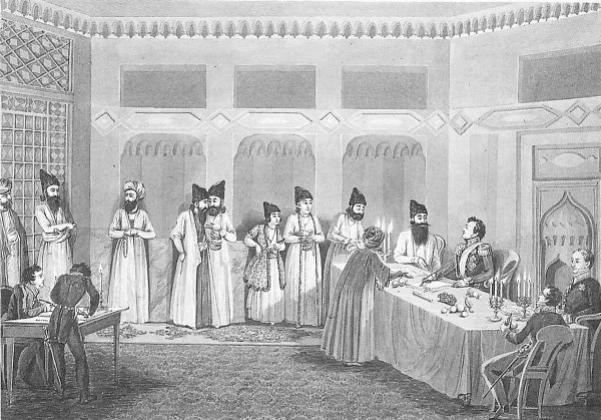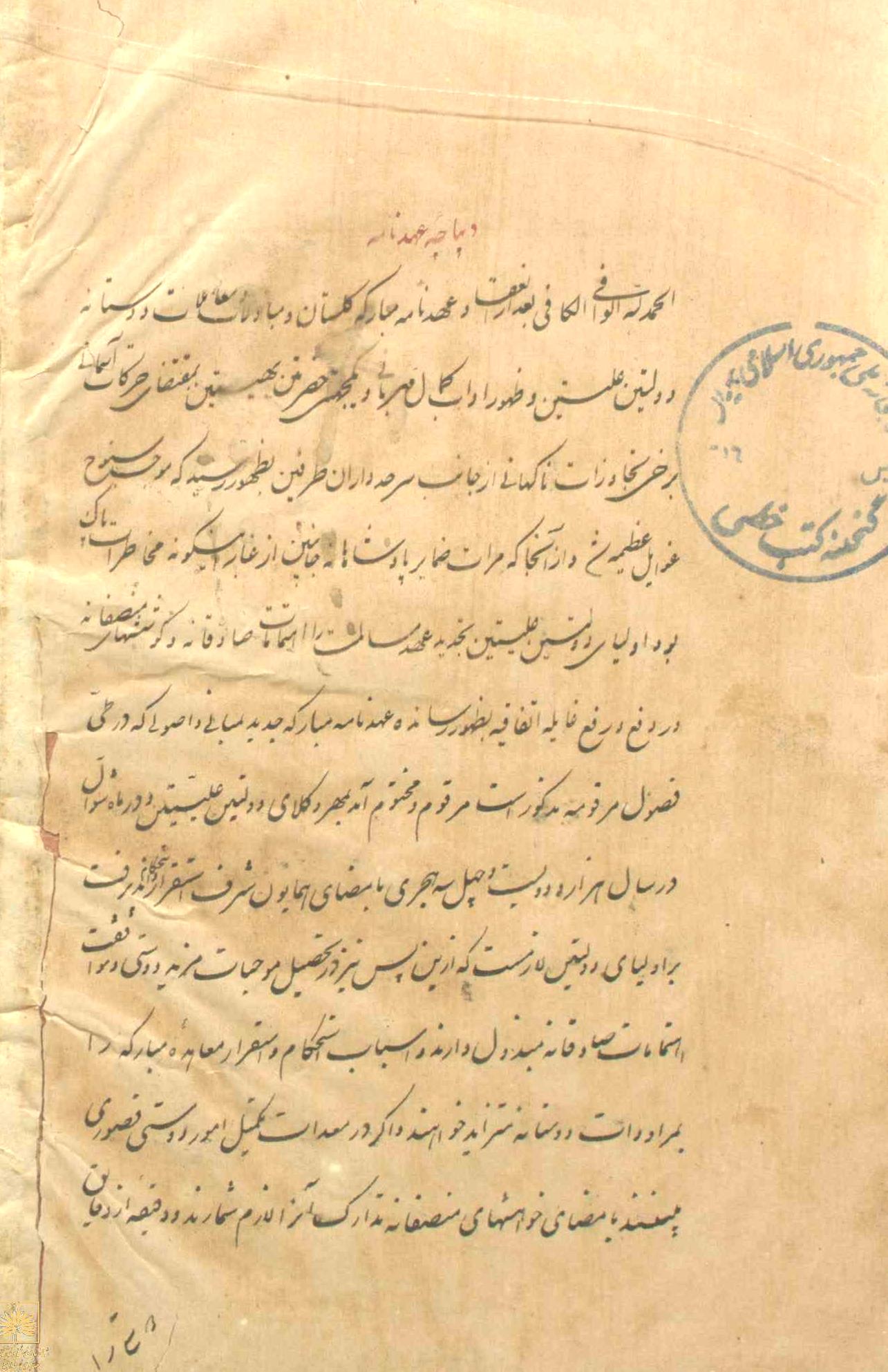Treaty of Turkmenchay
After the Treaty of Gulistan (1813), which was signed as a result of the wars waged by Russia to pursue an aggressive policy in the South Caucasus, worsening of relations between the Russian-Kajar State led to a new war. In July 1826 the army of Kajarian state crossed Araz and besieged Shusha but the city did not surrender. On July 26, Salyan was captured. By September the Talysh, Shirvan, Sheki, Karabakh and Yelizavetpol (Ganja) provinces were also captured. Russia then undertook counter-measures, won the Shamkir, Ganja and other battles and regained lost ground. There were no serious battles until February 1827.
The “Declaration” proclaimed by Russia on 16 September 1826, regarding the war, outlined the main provisions of a future peace treaty.
Qajar State’s efforts to bring the conflict to an end failed. Therefore Russian troops launched a new attack and on 26 June 1827 Nakhchivan was captured and on 7 July the fortress of Abbasabad surrendered. Negotiations resumed in July. As the threat of war with the Ottoman Empire increased, Russia sought to speed up the conclusion of peace. However, as these attempts failed, the new commander-in-chief of the Caucasian army, I. F. Paskevich, seized Irevan on 1 October 1827. At the end of 1826 the Russian troops that had entered South Azerbaijan extended their offensive in this direction. On 13 October 1827 Tabriz was captured. In November 1827 negotiations began again in Dehgargan.
But there was some considerable disagreement regarding reparations on 7 January 1828 which led to a break in negotiations. With a renewed offensive the Russian forces therefore increased the pressure on the Qajar state. Urmia was captured on 28 January and Ardabil on 8 February. This situation accelerated the conclusion of the treaty. On the night of February 9-10 1828 the treaty was signed in the village of Turkmanchay, 33 km north-west of Miane.
 The Treaty included 16 articles and proclaimed peace between Russian and Iran (Persia). The Article 1 said: “Henceforth and forever should remain the peace, friendship and the complete accord between His Majesty the all-Russian emperor and His Majesty the Persian shah, their heirs and successors, their countries and subjects”. The Article 2 confirmed the termination of mutual obligations under the Treaty of Gulistan and its replacement by the Treaty of Turkmenchay. The Article 3 acknowledged that the Qajar State had ceded the Iravan and Nakhchivan khanates to Russia; the Article 4 defined the borders: “All lands and all islands between the Caucasus mountains and the Caspian Sea... were recognised to belong to the Russian Empire”. The Article 6 stated that the Shah of Iran pledged to compensate the Russian Empire for the significant damage caused by the war between the two countries. The two High Contracting Parties agreed on the amount of the award in the twenty million silver rubles. The Article 8 said that as in the Gulistan Treaty, only Russian merchant ships still have the right to sail freely in and along the Caspian Sea and at the same time to approach them. As well only Russia could maintain a naval fleet on the Caspian Sea. The Articles 12-15 dealt with the resettlement of Armenians in the Azerbaijani khanates, the granting of privileges, the return of prisoners and other issues.
The Treaty included 16 articles and proclaimed peace between Russian and Iran (Persia). The Article 1 said: “Henceforth and forever should remain the peace, friendship and the complete accord between His Majesty the all-Russian emperor and His Majesty the Persian shah, their heirs and successors, their countries and subjects”. The Article 2 confirmed the termination of mutual obligations under the Treaty of Gulistan and its replacement by the Treaty of Turkmenchay. The Article 3 acknowledged that the Qajar State had ceded the Iravan and Nakhchivan khanates to Russia; the Article 4 defined the borders: “All lands and all islands between the Caucasus mountains and the Caspian Sea... were recognised to belong to the Russian Empire”. The Article 6 stated that the Shah of Iran pledged to compensate the Russian Empire for the significant damage caused by the war between the two countries. The two High Contracting Parties agreed on the amount of the award in the twenty million silver rubles. The Article 8 said that as in the Gulistan Treaty, only Russian merchant ships still have the right to sail freely in and along the Caspian Sea and at the same time to approach them. As well only Russia could maintain a naval fleet on the Caspian Sea. The Articles 12-15 dealt with the resettlement of Armenians in the Azerbaijani khanates, the granting of privileges, the return of prisoners and other issues.
Under the Treaty of Turkmenchay the population was allowed to move from South Azerbaijan to the South Caucasus and vice versa. As a result, many Armenian families migrated to the Karabakh and Iravan khanates. Both during the Russian-Kajar wars in 1804-1813 and 1826-1828, and later as a result of mass resettlement of Armenians from South Azerbaijan to South Caucasus, including to Karabakh, their number increased year by year. Only during the Russian-Kajar war in 1826-1828, 18 thousand Armenian families were resettled from the southern territories of Azerbaijan to the South Caucasus, including Karabakh. Under the Treaty of Turkmenchay, Armenians were allowed to resettle unhindered from the territory of Southern Azerbaijan into Russian territory. For two years, from 1828 to 1830, over 40 thousand South Azerbaijani and 84 thousand Turkish Armenians were resettled to the South Caucasus and settled in the most fertile lands of the Ganja, Karabakh and Iravan khanates where the Armenian population was small. Over 200,000 dessiatinas of “pantry of the Earth” were allocated to them.
The Treaty of Turkmenchay strengthened Russia’s strategic position in the Caucasus and laid the basis for further expansion of its political and economic influence in neighbouring countries. The territory of Northern Azerbaijan came fully under the control of Russia.
Recommended literature:
- Hüseynov, Yunis Rza oğlu. Azərbaycanın Qarabağ bölgəsinin tarixi / Y. R. Hüseynov ; red., ön sözün müəl. Z. H. Bayramlı. - Bakı : Afpoliqraf, 2019. - 208 s.
- Pakrəvan, Əminə Həsənxan qızı. Abbas Mirzə və Azərbaycan : monoqrafiya / Ə. H. Pakrəvan ; fars dilindən tərc. G. A. Gəncalp ; red. İ. Ucaruh. - Bakı : Qanun, 2010. - 336 s.
- Qafqazda "erməni məsələsi" : Rusiya arxiv sənədləri və nəşrləri üzrə: 1724-1914: 3 cilddə / Avropa-Azərbaycan Cəmiyyəti; tərt.-müəl.: T. K. Heydərov, T. R. Bağıyev, K. K. Şükürov ; red. heyəti: T. K. Heydərov [et al.]. - ISBN 978-9952-806-847. I cild : 1724-1904. - Bakı : Elm, 2010. - 716 s.
- Şükürov, Kərim Kərəm oğlu. Türkmənçay - 1828 : tarixi xronika / K. Şükürov ; elmi red. Y. M. Mahmudov ; red.: S. Turabova, T. Həmid. - Bakı : [n. y.], 2006. - 188 s.
- Алиев, Намик Гасан оглы. Армянская экспансия и международные договоры по Южному Кавказу в XIX-XX вв. : историко-правовое исследование / Н. Г. Алиев. - 2-е изд., доп. - Киев : Издательский дом Дмитрия Бураго, 2021. - 184 с.